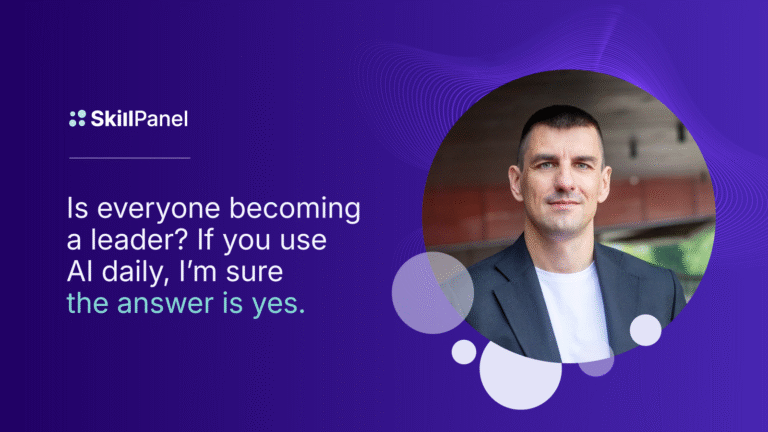
How to hire for positions that don’t exist yet (Hint: Stop hiring)
| Reading time:

The same movie, different technology
We’re watching a rerun. Companies today look for prompt engineers and AI engineers, and in the near future they’ll desperately search for AI Model Governance Specialists, Human-AI Collaboration Designers, and Algorithm Bias Detectives, complaining about the “talent shortage” while simultaneously laying off talented employees. Sound familiar? It should. We saw this exact same movie during the cloud transformation era.
I still remember smiling when I saw job postings demanding “5+ years of Kubernetes experience” when Kubernetes was barely three years old. The absurdity was obvious, yet companies kept posting these impossible requirements. Meanwhile, they were laying off the very people who had been managing their on-premise infrastructure for years – people who could have easily transitioned into these new roles with proper support.
History doesn’t repeat, but it certainly rhymes.
The uncomfortable truth about “new” roles
Here’s what I’ve learned from watching companies struggle with this repeatedly: When a role didn’t exist yesterday, the “perfect candidate” doesn’t exist today. Everyone – including that external “expert” you’re trying to hire – is learning on the job. The difference is, your internal candidates already understand your business context, culture, and systems. But you know they are learning on the job, while you want to believe people from the market already have the experience. Usually, most of them don’t.
As AI eats the world even faster than software did, every company in every industry faces the same challenge. We’re all creating roles for Avatar Trainers, AI Ethics Officers, and Digital Twin Managers. The candidate pool isn’t just shallow – it’s essentially non-existent.
Why internal mobility wins every time
The math is simple. When hiring for potential in an undefined role, you’re making a bet. With external candidates, you’re betting on:
- Their ability to learn (unknown)
- Their cultural fit (unknown)
- Their actual performance vs. interview performance (unknown)
- Their understanding of your business (zero)
With internal candidates, you already know:
- Who your high performers are
- Who are the fast learners
- Who’s eager to explore new areas
- Who understands your business inside out
Yet companies persist in the fantasy that the grass is greener in the external hiring market. News flash: In emerging fields, everyone is reskilling. That external “AI expert” you’re pursuing? They’re learning just like everyone else.
The talent hoarding problem
I’ve seen this pattern too many times to count. Managers operate like talent hoarders, telling their best people: “You’re such a great content writer, keep doing that, don’t lean into CRM management.” They fear losing their top performers to other departments.
Here’s the brutal reality I share with every manager I work with: These employees will leave anyway. The only question is whether they’ll move internally (keeping their knowledge in your company) or externally (taking it to your competitors). When someone wants to grow and you block their path, they don’t stay put – they quit. I’ve watched it happen repeatedly.
The solution isn’t just policy; it’s cultural transformation. Companies need to reward managers for developing people OUT of their teams, not for hoarding them. The best managers are talent developers, not talent hoarders.
The practical playbook
Based on what I’ve seen work (and fail) across organizations:
Stop writing traditional job postings
They don’t work for roles that don’t exist. Instead of waiting for candidates to arrive in your pipeline, look at what needs to be done and who internally could grow into it.
Create an internal talent marketplace
This can be as simple as internal job boards or as sophisticated as AI-powered matching platforms like SkillPanel. The technology matters less than the commitment to making internal moves frictionless. But here’s what I’ve learned: the most important thing is having managers who will support employees in such a movement, rather than trying to keep them inside their team using any effort available.
Run project-based trials
Instead of traditional interviews, give promising internal candidates actual projects. Hackathons, temporary assignments, or stretch projects reveal far more than any interview could. I’ve seen this approach uncover hidden talents that would never have emerged through traditional hiring.
Rethink your hiring criteria
Focus on:
- Experience (in solving similar problems, not specific technologies)
- Learning agility (how quickly they’ve mastered new domains)
Domain knowledge (least important due to the shortening half-life of skills)
The new operating model
From my experience, the future isn’t about choosing between specialists and generalists. It’s about creating teams where generalists supported by AI can accomplish remarkable things, with specialists reviewing and refining the outputs. This model allows for rapid scaling of new capabilities without the impossible task of hiring unicorns.
The bottom line
Companies have two choices when facing positions that didn’t exist yesterday:
- Continue the futile search for external candidates who don’t exist, complain about talent shortages, and watch your best internal people leave for companies that will give them growth opportunities.
- Recognize that in a world where job requirements change faster than job markets can respond, your best bet is to develop the talented people you already have.
The cloud transformation taught us this lesson already. Companies that invested in reskilling their infrastructure teams thrived. Those that insisted on external hiring while laying off internal talent struggled with both costs and execution.
With AI transformation, the stakes are higher and the pace is faster. We don’t have time to repeat the same mistakes. The talent you need isn’t out there in the market – it’s probably sitting three desks away, waiting for an opportunity to grow.
Stop hiring for positions that don’t exist. Start developing the people who already believe in your mission.





